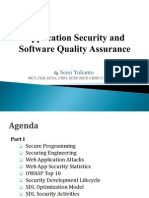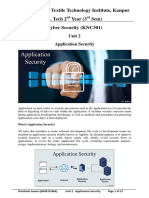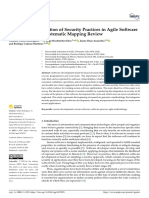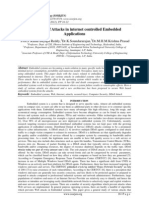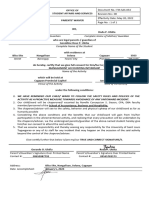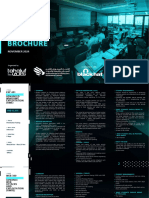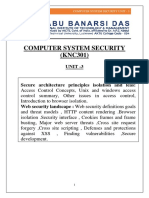0 ratings0% found this document useful (0 votes)
8 viewsProject READS CS ELECTIVE 2
Project READS CS ELECTIVE 2
Uploaded by
ZeusThe document discusses security measures for mitigating injection attacks and common web vulnerabilities like cross-site scripting and cross-site request forgery. It recommends input validation, content security policies, anti-CSRF tokens, same site cookies, and other strategies to enhance security.
Copyright:
© All Rights Reserved
Available Formats
Download as DOCX, PDF, TXT or read online from Scribd
Project READS CS ELECTIVE 2
Project READS CS ELECTIVE 2
Uploaded by
Zeus0 ratings0% found this document useful (0 votes)
8 views3 pagesThe document discusses security measures for mitigating injection attacks and common web vulnerabilities like cross-site scripting and cross-site request forgery. It recommends input validation, content security policies, anti-CSRF tokens, same site cookies, and other strategies to enhance security.
Original Title
Project-READS-CS-ELECTIVE-2
Copyright
© © All Rights Reserved
Available Formats
DOCX, PDF, TXT or read online from Scribd
Share this document
Did you find this document useful?
Is this content inappropriate?
The document discusses security measures for mitigating injection attacks and common web vulnerabilities like cross-site scripting and cross-site request forgery. It recommends input validation, content security policies, anti-CSRF tokens, same site cookies, and other strategies to enhance security.
Copyright:
© All Rights Reserved
Available Formats
Download as DOCX, PDF, TXT or read online from Scribd
Download as docx, pdf, or txt
0 ratings0% found this document useful (0 votes)
8 views3 pagesProject READS CS ELECTIVE 2
Project READS CS ELECTIVE 2
Uploaded by
ZeusThe document discusses security measures for mitigating injection attacks and common web vulnerabilities like cross-site scripting and cross-site request forgery. It recommends input validation, content security policies, anti-CSRF tokens, same site cookies, and other strategies to enhance security.
Copyright:
© All Rights Reserved
Available Formats
Download as DOCX, PDF, TXT or read online from Scribd
Download as docx, pdf, or txt
You are on page 1of 3
SCHOOL OF ENGINEERING, ARCHITECTURE, and IT EDUCATION
ITE Department
Project READS – Student Version
Second Semester SY 2023-2024
Name of Student Syd Roan Banag
Program/Year Level BSCS 3
Professor/Instructor Benedict D. Sy, DIT
1. Security Designs for the Cloud, IoT, and Social networking
Title of the Journals /
2. Wireless Security Architecture
Books
3. Security Fundamentals
1. Adele Kuzmiakova
Name of Author 2. Jennifer Minella
3. John Wiley
1. 2022
Year of publication 2. 2022
3. 2020
Answers to the guided
questions. 1. How can developers effectively mitigate the risk of injection
attacks in their software applications, and what best practices
should be followed to ensure robust program security?
= Developers can effectively mitigate the risk of injection
attacks in their software applications by implementing a
combination of best practices. Input validation plays a crucial
role, requiring developers to thoroughly validate and sanitize
user inputs to prevent malicious entries. The use of
parameterized statements or prepared queries in database
interactions helps thwart SQL injection attacks by separating
user input from SQL code. Additionally, employing stored
procedures can encapsulate and control database access, further
reducing the risk of injection. Adhering to the least privilege
principle, where database accounts and application components
are assigned minimal necessary privileges, limits potential
damage in the event of a breach. Escaping user input when
outputting it to web pages prevents cross-site scripting (XSS)
attacks. Web Application Firewalls (WAFs) provide an
additional layer of defense by filtering and blocking malicious
traffic. Regular security audits and penetration testing are
essential to identify and address potential vulnerabilities.
Furthermore, continuous education and training for developers
on secure coding practices and staying informed about the latest
security threats contribute to maintaining a robust program
security against injection attacks.
2. In the context of web applications, what measures can be
implemented to safeguard against common vulnerabilities such
as cross-site scripting (XSS) and cross-site request forgery
(CSRF), and how do these strategies contribute to enhancing
overall program security?
= To safeguard against common vulnerabilities like cross-site scripting
(XSS) and cross-site request forgery (CSRF) in web applications,
developers can implement the following measures:
1. Input Validation and Sanitization: Thoroughly validate and
sanitize user inputs to prevent malicious scripts from being
executed (XSS).
2. Content Security Policy (CSP): Implement CSP headers to
control which resources can be loaded, mitigating the risk of
XSS attacks by defining trusted sources for scripts and other
content.
3. Secure Cookies: Set the "HttpOnly" and "Secure" flags on
cookies to prevent client-side scripts from accessing sensitive
information and ensure cookies are transmitted over secure
connections only.
4. Anti-CSRF Tokens: Include anti-CSRF tokens in web forms to
verify the legitimacy of requests, making it challenging for
attackers to forge requests on behalf of authenticated users.
5. SameSite Attribute: Utilize the SameSite attribute for cookies to
control when they are sent with cross-site requests, reducing the
risk of CSRF attacks.
6. Frame-Options Header: Implement the X-Frame-Options header
to control whether a web page can be displayed in a frame,
preventing clickjacking attacks.
7. HTTP Strict Transport Security (HSTS): Enforce HSTS to
ensure secure connections, reducing the risk of man-in-the-
middle attacks and SSL-stripping.
8. Security Headers: Employ security headers such as X-Content-
Type-Options and X-Content-Security-Policy to provide an
extra layer of protection against various web vulnerabilities.
These strategies collectively enhance overall program security by
fortifying the application against common web vulnerabilities. By
implementing a combination of client-side and server-side defenses,
developers can significantly reduce the risk of XSS and CSRF attacks,
thereby bolstering the overall security posture of web applications.
______________________________________________________
Signature Over Printed Name of Librarian – in – Charge
_______________________________________________________
Date
You might also like
- CC Exam-1Document103 pagesCC Exam-1Ayoub Amellaln100% (11)
- Web Application Firewalls For DummiesDocument35 pagesWeb Application Firewalls For DummiesAgus HerdiyanaNo ratings yet
- Application Security and Secure ProgrammingDocument81 pagesApplication Security and Secure ProgrammingSemi YuliantoNo ratings yet
- Project READS CS ELECTIVE 2 AbellaDocument2 pagesProject READS CS ELECTIVE 2 AbellaZeusNo ratings yet
- A Survey On Web Application SecurityDocument6 pagesA Survey On Web Application Securitycristianscarisoreanu59No ratings yet
- CCS374 Web Application SecurityDocument18 pagesCCS374 Web Application Securitybarathkumar00001No ratings yet
- The Role of Full Stack Developers in Web Application SecurityDocument4 pagesThe Role of Full Stack Developers in Web Application SecuritycodewithtushpatNo ratings yet
- CCS374 Web Application SecurityDocument18 pagesCCS374 Web Application Securitydhanush02010No ratings yet
- Shinde2016 (Cyber Security Analysis Using Vulnerability Assessment and Penetration Testing)Document5 pagesShinde2016 (Cyber Security Analysis Using Vulnerability Assessment and Penetration Testing)lerebiNo ratings yet
- Application Security CloudDocument31 pagesApplication Security CloudM S Prasad100% (1)
- Kunal Darekar Seminar - ReportDocument18 pagesKunal Darekar Seminar - ReportKrishna DhokdeNo ratings yet
- CSS Question BankDocument19 pagesCSS Question BankArun ChoudharyNo ratings yet
- Deep Learning Technique-Enabled Web Application Firewall For The Detection of Web AttacksDocument16 pagesDeep Learning Technique-Enabled Web Application Firewall For The Detection of Web Attacksdanilo.chagasNo ratings yet
- Cybersecurity Best Practices For Python Web ApplicationsDocument25 pagesCybersecurity Best Practices For Python Web ApplicationsAbu RayhanNo ratings yet
- A Survey On Web Application Penetration TestingDocument23 pagesA Survey On Web Application Penetration TestingSpandana MlNo ratings yet
- SQL Injection Research PaperDocument5 pagesSQL Injection Research Paperpriyal agrahariNo ratings yet
- Smart Firewall Using Machine LearningDocument4 pagesSmart Firewall Using Machine LearningKaran RawatNo ratings yet
- SSRN Id3315587Document5 pagesSSRN Id3315587arslan zulfiqarNo ratings yet
- Unit 2 Application Security Another - PG 1 - 15Document15 pagesUnit 2 Application Security Another - PG 1 - 15Vishal100% (1)
- Unit 2 Application Security AnotherDocument27 pagesUnit 2 Application Security AnotherVishalNo ratings yet
- GhauriDocument5 pagesGhaurisubashsk111831No ratings yet
- 026-EASE-2022-Exploring Security Procedures in Secure Software Engineering A Systematic Mapping StudyDocument8 pages026-EASE-2022-Exploring Security Procedures in Secure Software Engineering A Systematic Mapping StudyMILYASNo ratings yet
- Extending SysML For Engineering DesignerDocument31 pagesExtending SysML For Engineering DesignerELVIS ARNALDO ARBOLEDA TERRONESNo ratings yet
- Secure Coding Practices and Vulnerability - RivadeloDocument4 pagesSecure Coding Practices and Vulnerability - RivadeloROLAND DAVE GUILLERMONo ratings yet
- Machine Learning For Detection and Mitigation of WDocument11 pagesMachine Learning For Detection and Mitigation of WFaycel MessaoudiNo ratings yet
- Software Development and Cyber Security Report BS7206Document52 pagesSoftware Development and Cyber Security Report BS7206ramphalnain52No ratings yet
- Application Security Interview QuestionsDocument39 pagesApplication Security Interview QuestionsRahul GoyalNo ratings yet
- 20RizkiEtAl IWBIS PreprintDocument7 pages20RizkiEtAl IWBIS PreprintBrandon CilNo ratings yet
- Assessment of Open Source Web Application Security ScannersDocument8 pagesAssessment of Open Source Web Application Security ScannersaylindubaNo ratings yet
- Web Vulnerability Detection and Security Mechanism: Katkar Anjali S., Kulkarni Raj BDocument5 pagesWeb Vulnerability Detection and Security Mechanism: Katkar Anjali S., Kulkarni Raj Bcrack wallNo ratings yet
- Ijet V3i6p82Document5 pagesIjet V3i6p82International Journal of Engineering and TechniquesNo ratings yet
- MLPXSS: An Integrated XSS-Based Attack Detection Scheme in Web Applications Using Multilayer Perceptron TechniqueDocument14 pagesMLPXSS: An Integrated XSS-Based Attack Detection Scheme in Web Applications Using Multilayer Perceptron TechniqueLưu Gia HuyNo ratings yet
- Literature Review of Distributed Denial of Service Attack ProtectionDocument7 pagesLiterature Review of Distributed Denial of Service Attack ProtectionIJRASETPublicationsNo ratings yet
- REPORT CSDocument4 pagesREPORT CSmanas.khannaNo ratings yet
- DaSCE: Data Security For Cloud EnvironmentDocument5 pagesDaSCE: Data Security For Cloud EnvironmentIJSTENo ratings yet
- Audit CousreDocument11 pagesAudit CousreYASH KOHAKADENo ratings yet
- Classification of SQL Injection Detection and Prevention MeasureDocument13 pagesClassification of SQL Injection Detection and Prevention MeasurePramono PramonoNo ratings yet
- (IJETA-V11I3P18) :pankaj Jain, Amit Kumar, Harshit Jain, Dhruv Vedwal, Harshit JainDocument5 pages(IJETA-V11I3P18) :pankaj Jain, Amit Kumar, Harshit Jain, Dhruv Vedwal, Harshit JaineditorijetaNo ratings yet
- ISM Report 3Document7 pagesISM Report 3Mayank PathakNo ratings yet
- Unit 5Document21 pagesUnit 5vinaykalva712No ratings yet
- Moustafa 2018Document13 pagesMoustafa 2018Johnwilliam PNo ratings yet
- A.barajk - Capari IcderttDocument12 pagesA.barajk - Capari Icderttranupyadav1011No ratings yet
- Seminar Project Excel2Document52 pagesSeminar Project Excel2fredricklucas16No ratings yet
- Case Study On SQL InjectionDocument5 pagesCase Study On SQL InjectionAtiya SharfNo ratings yet
- Priyal Keharia Is Exp 5Document19 pagesPriyal Keharia Is Exp 5Priyal KehariaNo ratings yet
- Coss Site Scripting AttacksDocument7 pagesCoss Site Scripting AttacksCarlosAVPNo ratings yet
- ProposalDocument10 pagesProposalAli BaidhaniNo ratings yet
- Electronics 11 02212 PDFDocument13 pagesElectronics 11 02212 PDFDaniel MopoNo ratings yet
- 025-IEEEAccess-2021-Systematic Mapping Study on Security Approaches in Secure Software EngineeringDocument22 pages025-IEEEAccess-2021-Systematic Mapping Study on Security Approaches in Secure Software EngineeringMILYASNo ratings yet
- Internship PresentationDocument16 pagesInternship Presentationddscraft123No ratings yet
- A Survey On Web Application Attacks: Gurvinder Kaur PannuDocument5 pagesA Survey On Web Application Attacks: Gurvinder Kaur PannuShahirul AzamNo ratings yet
- Prevention of Attacks in Internet Controlled Embedded ApplicationsDocument7 pagesPrevention of Attacks in Internet Controlled Embedded ApplicationsIOSRJEN : hard copy, certificates, Call for Papers 2013, publishing of journalNo ratings yet
- CS3340 Learning Journal Entry Unit 6 Truncation and Trimming Attacks, and SQL InjectionDocument3 pagesCS3340 Learning Journal Entry Unit 6 Truncation and Trimming Attacks, and SQL InjectionpohambadanielNo ratings yet
- OwaspDocument13 pagesOwasprasoul.ebrahimnzhadNo ratings yet
- A Complete Strategy For Web Application SecurityDocument17 pagesA Complete Strategy For Web Application Securitymemoona bibiNo ratings yet
- Web Application Vulnerabilities - The Hacker's TreasureDocument5 pagesWeb Application Vulnerabilities - The Hacker's TreasureBangsa PEJUANGNo ratings yet
- Information 15 00420Document20 pagesInformation 15 00420Ebtsam DosokyNo ratings yet
- Storage Security and Predictable Folder Structures in Cloud ComputingDocument8 pagesStorage Security and Predictable Folder Structures in Cloud ComputingAnonymous lPvvgiQjRNo ratings yet
- The Art of Cybersecurity: Defense in Depth Strategy For Robust ProtectionDocument20 pagesThe Art of Cybersecurity: Defense in Depth Strategy For Robust ProtectionMARCO ANTONIO PERALTA VALLEJONo ratings yet
- Essential Activities for Secure SoftwareDocument14 pagesEssential Activities for Secure SoftwareAbdulhadi AhmadNo ratings yet
- Threats and CountermeasuresDocument22 pagesThreats and CountermeasuresKeerthana SudarshanNo ratings yet
- Review Article: Network Attacks Detection Methods Based On Deep Learning Techniques: A SurveyDocument17 pagesReview Article: Network Attacks Detection Methods Based On Deep Learning Techniques: A SurveyjavaNo ratings yet
- Reading Assignment 1Document2 pagesReading Assignment 1ZeusNo ratings yet
- Midterm ENGF 1x2Document3 pagesMidterm ENGF 1x2ZeusNo ratings yet
- UbiñaDocument1 pageUbiñaZeusNo ratings yet
- AP-5903 - PPE & IntangiblesDocument10 pagesAP-5903 - PPE & Intangiblesxxxxxxxxx100% (1)
- Lesson 2 Structural Functionalism TheoryDocument23 pagesLesson 2 Structural Functionalism TheoryZeusNo ratings yet
- Vulnerabilities in Modern Web ApplicationsDocument34 pagesVulnerabilities in Modern Web ApplicationsNiyasNazar100% (1)
- LPU Live FormsDocument43 pagesLPU Live Formssreeramdevendra51No ratings yet
- Server Side Request ForgeryDocument20 pagesServer Side Request ForgerysureshNo ratings yet
- GamaSec Example ReportDocument42 pagesGamaSec Example ReportMefistogrNo ratings yet
- TechDefence Workshop FinalDocument57 pagesTechDefence Workshop FinalmailmelakshayNo ratings yet
- Pen Testing ResumeDocument1 pagePen Testing Resumejoel_parishNo ratings yet
- Broken Authentication and Session Management Vulnerability: A Case Study of Web ApplicationDocument7 pagesBroken Authentication and Session Management Vulnerability: A Case Study of Web ApplicationgkpalokNo ratings yet
- Cookies Privacyand Cyber SecurityDocument10 pagesCookies Privacyand Cyber Securityharsh guptaNo ratings yet
- OWASP Testing Guide NotesDocument5 pagesOWASP Testing Guide NoteshsaekjakNo ratings yet
- الأسئلة المتوقعة لمقابلات الأمن السيبرانيDocument8 pagesالأسئلة المتوقعة لمقابلات الأمن السيبرانيAbood AlotibiNo ratings yet
- Practical Analysis On The Algorithm of The Cross-Site Scripting AttacksDocument4 pagesPractical Analysis On The Algorithm of The Cross-Site Scripting AttacksVishal PatilNo ratings yet
- OWASPDocument226 pagesOWASPNguyen Hong PhuNo ratings yet
- Evalution of Findbugs: Arooj Fatima Anam Khan Sumaya BasheerDocument28 pagesEvalution of Findbugs: Arooj Fatima Anam Khan Sumaya BasheerArooj FatimaNo ratings yet
- Bypassing Dot NET ValidateRequestDocument24 pagesBypassing Dot NET ValidateRequestnicolasvNo ratings yet
- BCA IV Sem Cyber Law & Internet SecurityDocument22 pagesBCA IV Sem Cyber Law & Internet Securityshivansh.45715No ratings yet
- Website: Vce To PDF Converter: Facebook: Twitter:: Ecsav10.Vceplus - Premium.Exam.150QDocument49 pagesWebsite: Vce To PDF Converter: Facebook: Twitter:: Ecsav10.Vceplus - Premium.Exam.150QPhạm Mạnh CườngNo ratings yet
- 50 Cyber Security Interview Question & Answers For Sure Shot Success - Networking and SecurityDocument34 pages50 Cyber Security Interview Question & Answers For Sure Shot Success - Networking and SecurityC GNo ratings yet
- Ethical Hacking: Presented By: CYBER SHIELDDocument19 pagesEthical Hacking: Presented By: CYBER SHIELDHaval AbdulkarimNo ratings yet
- BHMEA 24 Training Brochure 2024 (1) 1Document67 pagesBHMEA 24 Training Brochure 2024 (1) 1samdig450No ratings yet
- Ethical Hacking: InternshalaDocument103 pagesEthical Hacking: InternshalaAravind DhananjeyanNo ratings yet
- UNIT - 3 NotesDocument32 pagesUNIT - 3 NotesSushant Yadav100% (1)
- Interview Questions For SOC AnalystDocument38 pagesInterview Questions For SOC Analystlllanos.awsNo ratings yet
- Fi 12100168Document37 pagesFi 12100168Mahfujul AlamNo ratings yet
- Chapter 3 QuizDocument4 pagesChapter 3 QuizSamuel TapusNo ratings yet
- Computer and Network SecurityDocument98 pagesComputer and Network SecuritySiddhant SidNo ratings yet
- bWAPP Intro PDFDocument91 pagesbWAPP Intro PDFkardeslerim123No ratings yet
- Bug Bounty TopicsDocument11 pagesBug Bounty TopicsAaron PreyNo ratings yet


